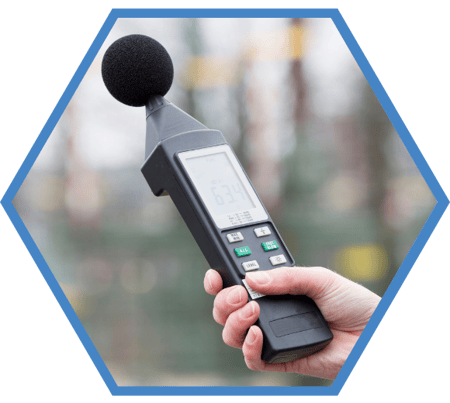NOISE MEASUREMENTS
Reducing noise at source
A regulatory priority in the workplace

By Hany Ghonaim | Founder at ODYO
Noise reduction first and foremost
Excessive noise in the workplace is one of the main risk factors for workers' health and well-being. Indeed, occupational deafness is one of the most frequent injuries in industrial environments. To remedy the situation, priority must be given to measures that eliminate or reduce noise at source. This approach not only meets the legal obligations set out in Quebec's Regulation respecting occupational health and safety (RROHS), but also guarantees lasting, effective protection for workers. Article 130 of the RROHS stipulates that employers must take the necessary measures to protect the health, safety and physical integrity of workers. This implies reducing noise at source through technical and administrative measures, before resorting to simpler but less effective solutions such as individual hearing protectors.
The importance of planning and initial choices
Section 132 of the RROHS highlights the key role of design and layout in noise reduction. It stipulates that when designing and fitting out an establishment, implementing a new process or making modifications, the employer must take reasonable steps to eliminate or reduce noise at source, or at least reduce worker exposure.
This also includes purchasing or replacing equipment, giving preference to the least noisy. However, these steps must ensure that they do not compromise other aspects of worker health and safety. This involves:
- Choosing optimal locations for noisy equipment.
- Including acoustic criteria in invitations to tender for the purchase of new machinery.
- Considering acoustics right from the architectural design phase.
Prevention is better than cure, as they say.
Noise exposure limits in Québec workplaces
In Quebec, regulations concerning noise exposure limits in the workplace were amended on June 16, 2023.
Section 131 of the RROHS sets out the new noise exposure limits in force:
- The daily noise exposure level is set at 85 dBA.
- The peak sound pressure level is set at 140 dBC.
Article 137 goes further, setting out clear guidelines for reducing noise exposure time.
- Single exposure: When a worker is confronted with a single work situation consisting of a single task or activity at risk of exceeding the exposure limit values, the employer must ensure that the exposure time does not exceed the maximum durations indicated in the following table:
| Equivalent continuous sound pressure level (dBA) | Maximum permissible duration per day |
|---|---|
| 82 | 16 hours |
| 83 | 12 hours |
| 85 | 8 hours |
| 88 | 4 hours |
| 91 | 2 hours |
| 94 | 1 hour |
| 97 | 30 minutes |
| 100 | 15 minutes |
| 103 | 7 minutes |
| 106 | 4 minutes |
| 109 | 2 minutes |
| 112 | 1 minute |
| 115 | 28 seconds |
| 118 | 14 seconds |
| 121 | 7 seconds |
| 124 | 3 seconds |
| 127 | 1 second |
| 130-140 | Less than one second |
-
Multiple exposure: When a worker is confronted with several tasks or activities at risk during the day, the employer is invited to use the calculator provided by the Commission des Normes, de l'Équité, de la Santé et de la Sécurité du Travail (CNESST) on its website to calculate the daily exposure level (Lex,8h). This level must comply with the daily noise exposure limit values.
This article does not allow work periods to be extended beyond the limits authorized by other laws, regulations, collective agreements or employment contracts.
Who can take noise measurements?
Since its amendment, Article 140 clearly sets out the qualifications required to carry out measurements of daily noise exposure and peak sound pressure levels. These measurements must be carried out by :
-
A professional or technician with training in occupational hygiene or specialized training in acoustics: These qualifications guarantee mastery of the scientific principles and techniques needed to accurately assess noise levels.
-
Any other person familiar with the best practices in noise measurement: This option offers a degree of flexibility, but requires demonstrable expertise and in-depth knowledge of measurement methods.
In addition, the employer may designate a person to assist the person carrying out the measurement, provided the latter retains full responsibility for the results.
This provision ensures that measurements are taken rigorously and accurately.
Reasonable ways to reduce noise
Section 135 of the RROHS specifies the reasonable means that employers must implement to meet noise reduction targets. These means include :
-
Equipment replacement: Replacing existing machines or equipment with quieter models.
-
Maintenance and corrective action: Ensure proper maintenance of equipment and make technical modifications to limit noise levels.
-
Limiting noise propagation: Implement solutions such as machine enclosure or soundproofing of premises and workplaces.
-
Isolating workstations: Protect workers by isolating high-risk areas.
When it is impossible to comply with exposure limit values, the employer is obliged to implement all identified means, even if these are not sufficient to achieve the prescribed exposure limits.
Noise reduction at source: Examples and techniques
To reduce noise at source, several strategies can be implemented, depending on the characteristics of the workplace and the equipment used. Here are some concrete examples:
-
Replacing equipment: Replace noisy machines with more modern models, designed to emit less noise. For example, opt for silent fans or compressors.
-
Preventive maintenance: Implement a regular maintenance program to avoid excessive vibrations or failures that increase noise. This includes tightening fasteners and lubricating moving parts.
-
Installation of acoustic barriers: Use acoustic panels or screens to separate noisy areas from work spaces. These barriers can be fixed or mobile, as required.
-
Enclosing machines: Build soundproof enclosures around particularly noisy equipment, such as generators or motors.
-
Room treatment: Reduce reverberation in rooms by adding absorbent materials such as acoustic wall panels, soundproof carpets or absorbent suspended ceilings.
-
Vibration reduction: Install vibration dampers or insulating bases under machines to limit noise transmission to surrounding structures.
-
Process optimization: Reorganize production flows to move noisy machines away from workstations, or schedule their use at times when the number of exposed workers is reduced.
-
Purchase silent tools: Choose low-noise electric or pneumatic tools, such as impact wrenches or silent drills.
-
Eliminating high-pitched noise: Install silencers or diffusers on ventilation or exhaust systems.
These measures significantly reduce noise at source, contributing to a safer, healthier working environment for employees.
Frequency and follow-up of noise assessments
Periodic noise assessment is essential to maintain a safe working environment that complies with legal requirements. Here is a summary of the main obligations:
Article 133: The employer must assess each work situation where exposure limit values are exceeded every five years. The purpose of this assessment is to :
- Identify ways of eliminating or reducing noise at source.
- Ensure compliance with established exposure limits.
- Reduce workers' exposure to noise.
The employer must begin implementing the means identified within one year of the assessment, and complete them before the next five-year assessment.
Article 134: When a risk situation changes, the employer has 30 days to identify it. Within the following year, he must :
- Measure noise exposure levels.
- Implement reasonable measures to reduce noise or comply with limit values.
If the next five-year assessment is less than two years away, the employer has a further two years in which to finalize the measures identified.
Article 138: The employer must measure noise exposure levels and peak sound pressure in the following cases:
- No reasonable means can be implemented to reduce noise.
- All reasonable means have been implemented.
These measurements must be taken within 30 days of the end of the deadline for identifying a reasonable means, or after the means have been fully implemented.
These provisions ensure rigorous monitoring and impose clear deadlines to guarantee the safety of workers in the face of noise-related risks.
Keeping records and posting reports
Article 141.4 requires the employer to post or circulate the measurement report no later than 15 days after it has been made available. This report must be accessible to workers in a visible place for at least 3 months.
In addition, according to article 141.5, the employer must include and keep up to date in the prevention program, or failing that in a register, the following information:
- Work situations at risk of exceeding noise exposure limit values, and the date on which they were identified.
- Reasonable measures taken to reduce noise, with start and end dates.
- Measurement reports.
These documents must be kept for a minimum period of 10 years, and made available to the parties concerned, including the CNESST and the establishment's medical officer.
This transparency is designed to promote proactive and effective management of noise-related risks.
Administrative measures
Under the RROHS, employers must also consider administrative measures to limit noise exposure. These measures include :
-
Scheduling: Reduce workers' exposure time by arranging rotations or breaks in quiet areas.
-
Workstation reconfiguration: Move workstations away from sources of intense noise.
-
Training and awareness-raising: Inform workers about the risks associated with noise and best practices for reducing its impact.
Use of personal protective equipment (PPE)
If, despite technical and organizational measures, noise remains at harmful levels, section 136 of the RROHS recommends the use of PPE, such as earplugs or earmuffs. These protections must be well adapted, comfortable and correctly used by workers. Moreover, the employer must provide hearing protection during the period required to implement a reasonable means of noise reduction, and during the period required to repair or maintain noisy machinery or equipment.
Prevention that goes beyond regulations
Adopting a strategy to reduce noise at source is a benevolent gesture that benefits everyone. Sections 130 to 141 of the RROHS emphasize the importance of reducing noise at source, an essential responsibility for employers. By implementing technical and administrative solutions, and by actively engaging workers, we can together create healthier and safer working environments for all. Preventing hearing loss caused by noise exposure should not be seen solely as a legal obligation, but as a genuine commitment to the health and well-being of everyone at work.

Assess the risk with noise measurements in your company
Start your hearing loss prevention program with reliable noise measurements to develop an effective action plan to prevent occupational hearing loss.

-1.png?width=144&height=72&name=BJA%20_%20Logo%20Color%20%20(1)-1.png)
